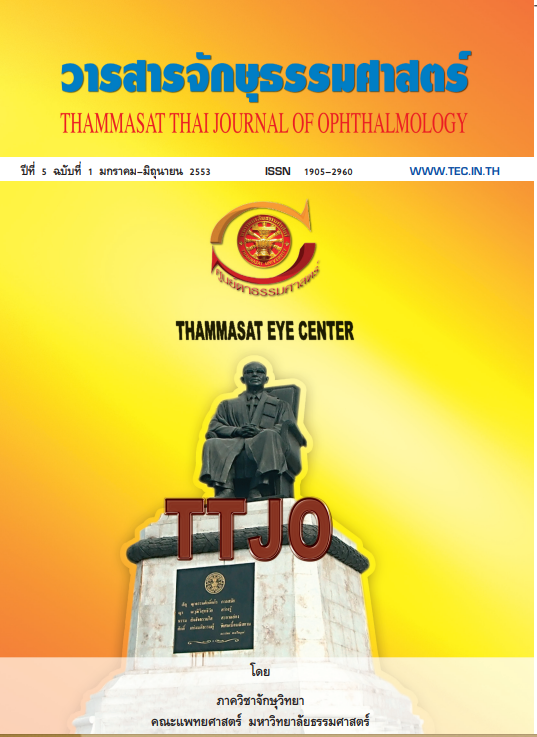ค่าปกติของความโปนลูกตาของกลุ่มตัวอย่างในโรงพยาบาลธรรมศาสตร์เฉลิมพระเกียรติ
Main Article Content
Abstract
วัตถุประสงค์: เพื่อหาค่าปกติของความโปนลูกตาในกลุ่มตัวอย่างในโรงพยาบาลธรรมศาสตร์เฉลิมพระเกียรติ
รูปแบบการศึกษา: การศึกษาเชิงพรรณนา (cross sectional dessriptive study)
วิธีการศึกษา: ใช้ Hertel exophthalmometer วัดค่าความโปนของลูกตาในกลุ่มตัวอย่างในโรงพยาบาลธรรมศาตร์เฉลิมพระเกียรติ จำนวน 504 คน โดยใช้ผู้วัดเพียงคนเดียว แล้วนำค่าที่วัดได้ คอ ความกว้างระหว่างกระดูกเบ้าตาด้านนอก (base) และค่าความโปนลูกตาของตาข้างขวาและซ้ายมาวิเคราะห์ทางสถิติ โดยมีการทดสอบความน่าเชื่อถือในค่าตาโปนที่วัดของผู้วิจัย จากการวัดค่าใน 40 คนแรก
ผลการศึกษา: ในการวัดความโปนของลูกตาในผู้ป่วย 40 คนแรก Intra-rater reliability ได้ค่า Intraclass Correlation Coefficient (ICC) = 0.95 (95% confidence interval (CI) = 0.89-0.97) และ Interrater reliability ได้ค่า ICC = 0.81 (95% CI = 0.74-0.87) กลุ่มตัวอย่าง 504 คน เป็นผู้หญิง 288 คน ผู้ชาย 16 คน อยู่ในช่วงอายุ 20-86 ปี อายุเฉลี่ย 51.87 ปี ความโปนของลูกตาในกลุ่มผู้หญิงที่วัดได้มีค่าเฉลี่ยเท่ากับ 13.56 +- 2.34 มม. ความโปนของลูกตาในกลุ่มผู้ชายมีค่าเฉลี่ยเท่ากับ 15.02 +- 2.57 มม. ค่าความแตกต่างของความโปนระหว่างลูกตาทั้งสองข้าง (asymmetry) มีค่าอยู่ระหว่าง 0-2 มม. โดยมีค่าเฉลี่ย 0.35 มม.
สรุป: จากการศึกษานี้พบว่า ผลการศึกษาเป็นไปในทางเดียวกันกับการศึกษาอื่นๆ คือได้ค่าเฉลี่ยของความโปนของลูกตาของกลุ่มตัวอย่างต่ำกว่าในคนผิวดำและผิว ขาวแต่ได้ค่าเฉลี่ยใกล้เคียงกับประเทศในทวีปเอเชียประเทศอื่น ซึ่งการตระหนักถึงความแตกต่างของความโปนของลูกตาเหล่านี้เป็นสิ่งสำคัญในการ นำไปใช้ทางคลินิก เพื่อให้สามารถบอกถึงภาวะตาโปนที่จำเป็นต้องเปรียบเทียบกับค่าปกติของเชื้อ ชาตินั้น
Exophthalmometric Value of a Sample in Thammasat University Hospital
Objective: To determine normal exophthalmometric value of a sample in Thammasat University Hospital
Study design: Cross sectional descriptive study
Methods: Measurement of exophthalmos was performed with Hertel exophthalmometer by one examiner in 504 normal Thai subjects in Thammasat University Hospital. The values of exophthalmos, asymmetry and base were evaluated. Inter-rater and intra-rater reliability were tested in 40 subjects for evaluation of examinerûs reliability.
Results: Intraclass Correlation Coefficient for inter-rater and intra-rater reliability were 0.81 and 0.95 respectively. In 504 subjects, the mean exophthalmos of 288 female was 13.56 ± 2.34 mm. The mean exophthalmos of 216 males was 15.02 ± 2.57 mm. The mean difference between both eyes (asymmetry) was 0.35 mm. There was no difference between both eyes greater than 2 mm.
Conclusions: Exophthalmometric value in this study was in line with previous studies that tended to be lower than those of Caucasian and black people, but are close to those of other countries in Asia. Exophthalmometric value varied widely among different populations. By recognizing and adjusting ethnic variations are important to detect normal and abnormal exophthalmometric value for the diagnosis of many orbital diseases.
Article Details
References
Mourits MP, Lombardo SH, van der Sluijs FA, Fenton S. Reliability of exophthalmos measurement and the exophthalmometry value distribution in a healthy Dutch population and in Gravesû patients. An exploratory study. Orbit 2004;23:161-8.
Kumari SP, Gupta VP, Pandey RM. Exophthalmometric values in a normal Indian population. Orbit 2001;20:1-9.
Dunsky IL. Normative data for Hertelûs exophthalmometry in a normal adult black population. Optom Vis Sci 1992;69:562-4.
Barretto RL, Mathog RH. Orbital measurement in black and white populations. Laryngoscope 1999;109:1051-4.
De Juan E, Hurley DP, Sapira JD. Racial differences in normal values of proptosis. Arch Intern Med 1980;140:1230-1.
Migliori ME, Gladstone GJ. Determination of the normal range of exophthalmometric values for black and white adults. Am J Ophthalmol 1984;98:438-42.
C-C Tsai, H-C Kau, S-C Kao, W-M Hsu. Exophthalmos of patients with Gravesûdisease in Chinese of Taiwan. Eye 2006;20:569-73.
Kim IT, Choi JB. Normal range of exophthalmos values on orbit computerized tomography in Koreans. Ophthalmologica 2001;215: 156-162.
Osuobeni EP, al Harbi AA. Normal values of ocular protrusion in Saudi Arabian male children. Optom Vis Sci 1995;72:557-64.
Amino N, Yuasa T, Yabu Y, Miyai K, Kumahara Y. Exophthalmos in autoimmune thyroid disease. J Clin Endocrinol Metab 1980;51:1232-4.
Naugle TC Jr, Couvillion JT. A superior and inferior orbital rim-based exophthalmometer (orbitometer). Ophthalmic Surg 1992 Dec;23(12):836-7.
Cole HP 3rd, Couvillion JT, Fink AJ, Haik BG, Kastl PR. Exophthalmometry: a comparative study of the Naugle and Hertel instruments. Ophthal Plast Reconstr Surg 1997 Sep;13(3):189-94.
Sumalee V, Kanograt P, Prija M, Kriporn C. Normal Exophthalmometric Values in Thais. Thai J Ophthalmol 2002; January-June 16(1):39-42.
Verasak S,Vitaya S,Thongkum S. Proptosis in Normal Thai samples and thyroid patients. J Med Assoc Thai 2007;90(4):679-83.
Prabhakar BS, Bahn RS, Smith TJ. Current perspective on the pathogenesis of Gravesû disease and ophthalmopathy. Endocr Rev 2003;24:802-35.


